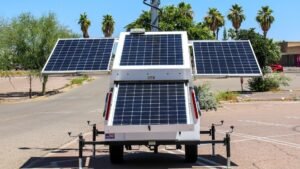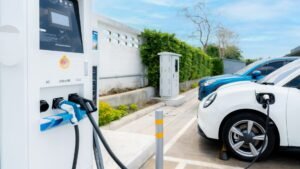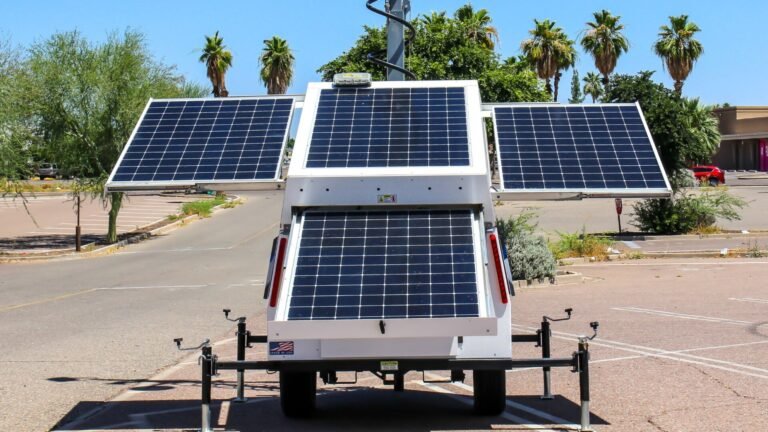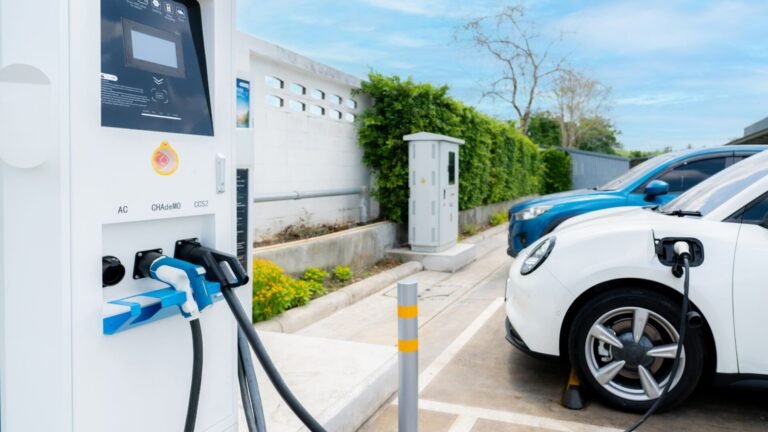Urban farming is not a new concept, but the integration of solar power into these urban farms is revolutionizing city landscapes in Europe.
As cities grow and the demand for fresh, local produce increases, innovative solutions like solar-powered farms are becoming essential.
Solar power not only makes urban farming more sustainable but also more efficient and cost-effective. By harnessing renewable energy, these farms can operate independently of traditional power grids, reducing their carbon footprint and promoting environmental stewardship.
This blog delves into why solar-powered urban farms are the next big thing in European cities, highlighting their benefits, challenges, and the impact they have on urban environments.
The Rise of Urban Farming in Europe
Solar powered urban farming has been gaining momentum across Europe as cities strive to become more sustainable and self-sufficient.
The concept involves growing food in urban areas, utilizing spaces such as rooftops, vacant lots, and even walls. Urban farming addresses several critical issues, including food security, reduction of food miles, and improved urban green spaces.
It also fosters community engagement and provides educational opportunities, making city environments more vibrant and interconnected.
Urban farming is not only about producing food but also about transforming urban areas into green spaces that enhance biodiversity and mitigate the urban heat island effect.
These green spaces can improve mental health and overall well-being by providing residents with access to nature.
However, one of the significant challenges urban farms face is energy consumption, especially in controlled environment agriculture systems.
These systems require substantial energy for lighting, heating, and cooling, which can be costly and environmentally damaging if reliant on fossil fuels.
As urban farms expand and evolve, finding sustainable energy solutions becomes imperative to maintain their ecological benefits and economic viability.
Enter Solar-Powered Urban Farms
Solar-powered farms present a viable solution to the energy challenge faced by urban farms. By harnessing the power of the sun, these farms can significantly reduce their reliance on non-renewable energy sources, cutting down both costs and carbon footprints.
Solar power is a renewable, abundant energy source that can be used to run various systems within an urban farm, making it a sustainable option for city farming.
The integration of solar panels into urban farming infrastructure not only provides a consistent and clean energy supply but also aligns with the broader goals of environmental sustainability and energy efficiency.
Additionally, solar power can enhance the resilience of urban farms by reducing their vulnerability to energy price fluctuations and supply disruptions.
This approach ensures that urban farms can continue to operate smoothly and sustainably, even in the face of growing energy demands and environmental challenges.
Benefits of Solar-Powered Urban Farms
- Sustainability and Reduced Carbon Footprint: Solar-powered farms contribute significantly to environmental sustainability by utilizing renewable energy.
This reduces greenhouse gas emissions and reliance on fossil fuels, aligning with Europe’s ambitious climate goals.
Moreover, by decreasing the carbon footprint associated with energy consumption, these farms help mitigate climate change impacts.
The adoption of solar energy in urban farming also fosters a culture of sustainability within communities, encouraging other green initiatives and eco-friendly practices. - Cost Savings: Although the initial setup costs for solar panels can be high, the long-term savings on energy bills are substantial.
Urban farms can become more economically viable by reducing their operational costs through solar power. Over time, the return on investment for solar infrastructure can be considerable, allowing urban farms to allocate resources to other areas such as technology upgrades and expansion.
Additionally, various government incentives and subsidies can offset initial costs, making solar power an even more attractive option for urban farmers. - Energy Independence: Solar-powered farms can operate independently of the traditional power grid, ensuring a stable and reliable energy source.
This is particularly beneficial in urban areas where energy demand is high, and power outages can occur. By generating their own power, urban farms can avoid the disruptions and costs associated with grid dependency.
This autonomy not only enhances operational reliability but also provides a model for energy resilience that can inspire broader applications in other urban infrastructure projects. - Increased Food Security: By producing food locally, urban farms reduce the dependency on imported produce. Solar-powered farms enhance this benefit by ensuring consistent energy for year-round production, regardless of seasonal changes.
This stability in food production can lead to more predictable food supplies and prices, benefiting urban populations. Additionally, local food production can reduce the environmental impact of transportation and storage, contributing to a more sustainable food system overall. - Improved Urban Environments: Urban farms contribute to greener cityscapes, improving air quality and providing recreational and educational opportunities for residents.
Solar-powered farms further this by promoting clean energy use within urban environments. The presence of green spaces in cities can reduce urban heat island effects, enhance biodiversity, and provide social and mental health benefits to residents.
Educational programs centered around solar-powered farming can also raise awareness about renewable energy and sustainable living, fostering a more environmentally conscious community.
How Solar-Powered Farms Work
Solar-powered farms use photovoltaic panels to convert sunlight into electricity. These PV panels are typically installed on rooftops, open fields, or integrated into the structures of greenhouses.
The electricity generated by the panels can power various farm operations, including lighting, irrigation systems, temperature control, and even electric vehicles used for transporting produce.
Advanced systems also allow for the automation of these processes, making the farm more efficient. Additionally, excess energy generated during peak sunlight hours can be stored in batteries for use during cloudy days or nighttime, ensuring a consistent power supply.
Some farms also integrate smart grid technology, which enables them to sell excess energy back to the grid, creating an additional revenue stream.
This energy resilience is crucial for maintaining continuous operation and reducing reliance on fossil fuels, contributing to the overall sustainability of urban farming.
Case Studies: Solar-Powered Urban Farms in Europe
- Rooftop Farms in Berlin, Germany: Berlin is home to several rooftop farms that utilize solar power. These farms grow a variety of vegetables and herbs, providing fresh produce to local restaurants and markets. The use of solar panels ensures that the farms are energy-efficient and sustainable.
- Solar Greenhouses in Barcelona, Spain: Barcelona has seen a rise in the use of solar greenhouses, which use solar panels to generate electricity for climate control systems. This allows for the year-round production of crops, regardless of external weather conditions.
- Vertical Farms in London, UK: London has embraced vertical farming, where crops are grown in vertically stacked layers. These farms often use solar power to operate LED grow lights and climate control systems, maximizing space and energy efficiency.
Challenges and Solutions
While the benefits of solar-powered farms are clear, there are challenges to their widespread adoption.
- Initial Costs: The initial investment in solar panels and associated infrastructure can be high. However, various government grants, subsidies, and financing options are available to support urban farmers in making this transition.
- Space Constraints: Urban areas have limited space for installing solar panels. Innovative solutions, such as integrating panels into building materials or using vertical installations, can help overcome this challenge.
- Weather Dependency: Solar power generation can be affected by weather conditions. By incorporating energy storage solutions and hybrid systems that combine solar with other renewable sources, urban farms can ensure a reliable energy supply.
The Future of Solar-Powered Urban Farms
The future of urban farming in Europe is bright, with solar-powered farms at the forefront of this transformation.
As technology advances and the cost of solar panels continues to decrease, more urban farms will likely adopt solar power.
This shift not only supports Europe’s sustainability goals but also enhances urban resilience and food security.
Moreover, the integration of smart technologies, such as IoT and AI, can optimize energy use and crop management, making solar-powered farms even more efficient and productive.
Innovations such as agrivoltaics, where solar panels are combined with crop production on the same land, are also gaining traction.
This approach maximizes land use efficiency and offers additional benefits such as shading crops from extreme heat. Furthermore, it provides an additional revenue stream for farmers through energy production, making urban farming more economically viable.
With these advancements, solar-powered urban farms are poised to become a critical component of sustainable urban development, leading to greener cities and healthier communities.
Conclusion
Solar-powered farms are undoubtedly the next big thing in European cities. They offer a sustainable solution to the energy challenges faced by urban farms, reducing carbon footprints and operational costs.
By embracing solar power, urban farms can contribute to greener, more resilient cities, providing fresh, local produce year-round.
As cities continue to grow and the demand for sustainable solutions increases, solar-powered farms will play a crucial role in shaping the urban landscapes of the future.
By investing in solar-powered urban farms, Europe can take a significant step towards achieving its climate goals and ensuring food security for its urban populations.
In conclusion, the integration of solar power into urban farming is a game-changer. Solar-powered farms offer a sustainable, cost-effective, and reliable solution to urban farming’s energy needs.
As more cities across Europe adopt this innovative approach, the benefits will extend beyond just fresh produce, contributing to healthier, greener, and more sustainable urban environments. The future of urban farming is here, and it is powered by the sun.
By focusing on the potential and advantages of solar-powered farms, we can drive traffic to our website and enhance our ranking on search engines.
As more people become aware of the benefits of solar-powered urban farming, the demand for information and solutions will grow, solidifying the importance of this innovative approach in the urban landscapes of Europe.





